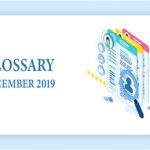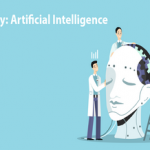Alexa Voice Service (AVS):
Amazon’s service offering for a voice controlled AI assistant. Offered in different products.
Source: https://whatis.techtarget.com/definition/Alexa-Voice-Services-AVS
Blockchain Infrastructure:
A complex, decentralized architecture that orchestrates many systems running asynchronously over the internet in order to create a secured database that records sensitive data of certain users into forms of transactions,
Source: https://blockgeeks.com/guides/what-is-blockchain-technology/
Chatbot:
An automated program that interacts with people using generated responses from keywords.
Source: https://searchcustomerexperience.techtarget.com/definition/chatbot
Conversational User Interface (CUI):
Any interface that can converse with people on a personal, social level.
Source: https://blog.aimultiple.com/conversational-ui/
DevOps:
A software development practice, grounded in agile philosophy that emphasizes close collaboration between an organization’s software developers and other IT professionals, while automating the process of software delivery and infrastructure changes. It aims at establishing a culture and organizational workflow in which building, testing, and releasing software happens rapidly, frequently, and more reliably.
Term derived from the words “Development” and “Operations”.
Source: https://magazine.logigear.com/glossary/software-testing-master-glossary/#letter-D
Emotional Intelligence:
The capacity to be aware of, control, and express one’s emotions, and to handle interpersonal relationships judiciously and empathetically. “Emotional intelligence is the key to both personal and professional success”.
Source: https://magazine.logigear.com/glossary/software-testing-master-glossary/#letter-E
Human-Machine Interface (HMI):
A human machine interface (HMI) is the user interface that connects an operator to the controller for an industrial system.
Intelligent Virtual Assistant (IVA):
An automated AI system that can perform human-like tasks, such as grocery shopping or scheduling appointments.
Source: https://www.interactions.com/blog/intelligent-virtual-assistant/rise-intelligent-virtual-assistants/
Lean:
Lean software development is a translation of lean manufacturing and lean IT principles and practices to the software development domain. Adapted from the Toyota production system, a pro-lean subculture is emerging from within the Agile community. When lean documentation is employed, it will result in reduced waste of time, money, and resources.
Source: https://magazine.logigear.com/glossary/software-testing-master-glossary/#letter-L
Natural Language Processing (NLP):
The ability for a computer to comprehend spoken or written word, enabling interaction between humans.
Source: https://www.sas.com/enus/insights/analytics/what-is-natural-language-processing-nlp.html
Natural Language Understanding (NLU):
A category of Natural Language Processing that deals with machine reading comprehension.
Source: https://www.gartner.com/it-glossary/nlu-natural-language-understanding/
Speech Recognition Engine (SRE):
The ability for a computer to recognize spoken word and translate it into code.
Source: https://www.softwaresuggest.com/speech-recognition-engine
Unit Testing:
Unit testing is a software development process in which the smallest testable parts of an application, called units, are individually and independently scrutinized for proper operation. Unit testing is often automated but it can also be done manually. This testing mode is a component of Extreme Programming (XP), a pragmatic method of software development that takes a meticulous approach to building a product by means of continual testing and revision.
Source: https://magazine.logigear.com/glossary/software-testing-master-glossary/#letter-U
Universal Windows Platform (UWP):
An API created by Microsoft and first introduced in Windows 10; the purpose of this platform is to help develop universal apps that run on Windows 10, Windows 10 Mobile, Xbox One, and HoloLens without the need to be re-written for each. UWP allows developers to create apps that will potentially run on multiple types of devices.
Source: https://en.wikipedia.org/wiki/Universal_Windows_Platform
XPath:
Also referred to as XML Path Language, it’s a query language for selecting nodes from an XML document.


















